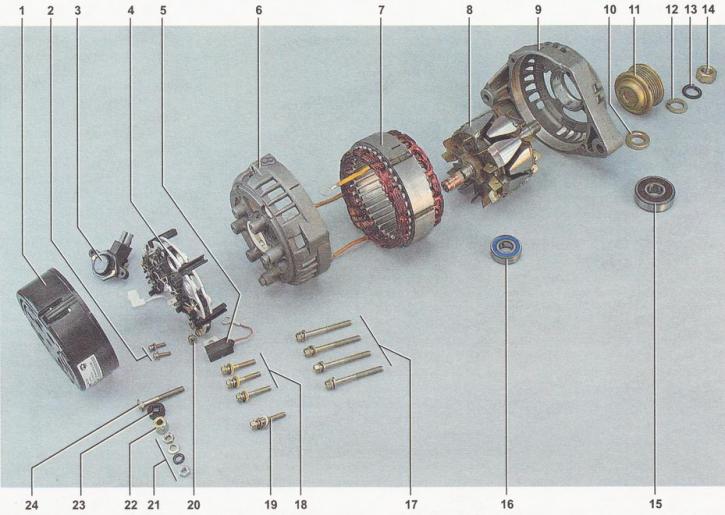A generator is an electrical machine that converts mechanical energy generated by an engine into electrical energy. When the rotor rotates, an alternating current is generated in the three stator windings of the generator, for converting which into a direct current, a rectifier unit based on semiconductor diodes is installed in the generator. The voltage generated by the current generator depends on the rotor speed and the strength of the excitation current flowing through the rotor winding (excitation winding).
To regulate the current strength in the excitation winding, an automatic voltage regulator is built into the generator. It maintains a constant voltage in the range of 13.2-14.7 V in the vehicle's on-board electrical network, regardless of the engine speed. With the simultaneous operation of powerful consumers of electricity and a low frequency of rotation of the crankshaft (at idle) the voltage in the vehicle's on-board network may be below the specified limit. At the same time, the battery stops charging, and with a large current consumption, it even starts to discharge.
Weak tension of the alternator drive belt leads to its slipping along the pulleys, which does not allow the generator to develop the necessary power and leads to rapid belt wear. Indirect belt slip
The alternator can be identified by the dim glow of the headlights at night and by the whistling sound in the front of the engine when the crankshaft speed is increased.
Recommendation. If the panel (shield) the control lamp of the battery charge lights up, do not rush to immediately remove the generator for repair or replacement. First, check the serviceability of the fuse F19, the supply of + 12V voltage to the excitation winding of the generator when the ignition is turned on (connector D) and alternator drive belt tension. The serviceability of the generator can be checked without removing it from the engine.

Generator Wiring Diagram: 1 - battery; 2 - generator; 3 - mounting block; 4 - ignition switch; 5 - generator malfunction warning lamp in the instrument panel

Generator details: 1 - protective cover of the rectifier unit; 2 - screws for fastening the voltage regulator; 4 - rectifier block; 5 - capacitor; 6 - back cover; 7 - stator with windings; 8 - rotor; 9 - front cover; 10 - remote bushing; 11 - pulley; 12 - washer; 13 - spring washer; 14 - pulley fastening nut; 15 - front bearing; 16 - rear bearing; 17 - coupling bolts of covers; 18 - bolts (with insulating gaskets) fastening of the block of rectifiers and conclusions of windings of the stator; 19 - bolt (without insulating pad) fastening of the block of rectifiers; 20 - capacitor mounting screw; 21 - fastening elements of the contact bolt; 22 - remote bushing; 23 - insulating sleeve; 24 - pin bolt
